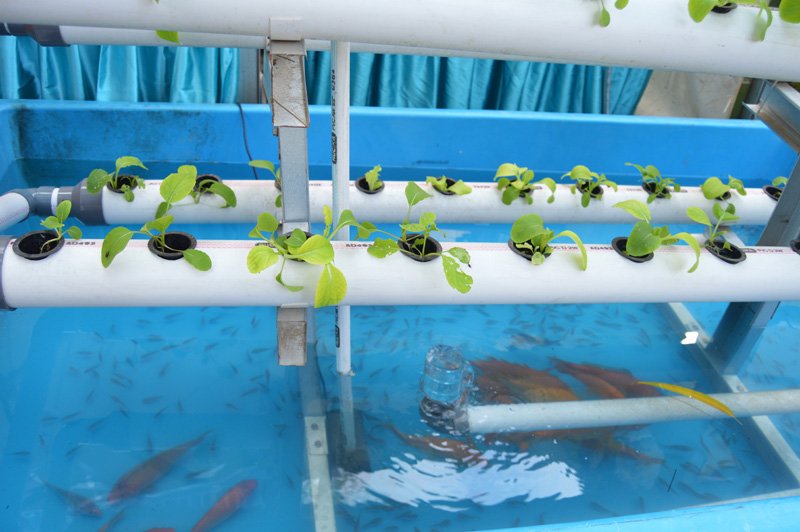Aquaponics is a delicate ecosystem where fish, plants, and beneficial bacteria work together in a symbiotic cycle. The fish provide waste, which bacteria convert into nutrients for plants, while plants filter the water to keep fish healthy.
But maintaining this nutrient balance isn’t automatic. Too much fish waste can harm plants and fish, while too little nutrients can stunt plant growth. In this post, we’ll explore how to manage nutrients effectively to keep your aquaponic system thriving.
1. The Aquaponic Nutrient Cycle: How It Works
The core of aquaponics is the conversion of fish waste into plant-usable nutrients. Here's how the cycle works:
1️⃣ Fish produce waste (ammonia) through respiration and excretion.
2️⃣ Beneficial bacteria convert ammonia → nitrites → nitrates (which plants absorb).
3️⃣ Plants take up nitrates and other nutrients, filtering the water before it returns to the fish.
👉 If nutrients are too high: Fish may suffer from poor water quality (high ammonia or nitrates).
👉 If nutrients are too low: Plants may struggle to grow due to deficiencies.
💡 Goal: Maintain a balance where plants get enough nutrients without overloading the system.
2. Key Nutrients in Aquaponics and Their Role
Different nutrients affect plant growth in different ways. Fish waste provides some essential nutrients, but you may need supplements to ensure balanced plant nutrition.
Nutrient Function Source in Aquaponics Nitrogen (N) Leaf growth, green color Fish waste (ammonia → nitrates) Phosphorus (P) Root & flower development Fish food, added supplements Potassium (K) Disease resistance, fruiting Fish food, potassium-based additives Calcium (Ca) Strong cell walls, preventing blossom-end rot Crushed eggshells, calcium carbonate Iron (Fe) Chlorophyll production (prevents yellowing leaves) Chelated iron (Fe-EDDHA or Fe-DTPA) Magnesium (Mg) Photosynthesis, green leaves Dolomite lime, Epsom salts Sulfur (S) Enzyme production, plant metabolism Fish food, naturally present in water📌 Common Deficiency Symptoms:
-
Yellowing leaves? 🟡 Lack of iron or nitrogen.
-
Weak roots or poor flowering? 🚫 Phosphorus deficiency.
-
Spots or curled leaves? 🌀 Calcium or magnesium imbalance.
3. How to Maintain Nutrient Balance
A. Adjusting Fish Stocking Density
Fish produce the nutrients your plants need. Too many fish = excessive waste, too few = nutrient deficiencies.
📌 Ideal Ratio:
-
1 kg of fish per 5-7 square feet of plant area.
-
Adjust stocking density based on plant demand.
👉 More plants? Increase fish feed OR add supplements.
👉 More fish? Add more filtration or increase plant volume.
B. Choosing the Right Fish Feed
Fish food is the main source of nutrients in aquaponics. The quality of feed affects plant health.
Look for high-quality feed that contains:
✔ Nitrogen & phosphorus (for plant growth).
✔ Essential minerals (iron, calcium, potassium).
✔ Balanced protein (for fish health).
🐟 Pro Tip: Floating pellets reduce uneaten food buildup, preventing water quality issues.
C. Managing pH for Nutrient Uptake
pH affects how well plants absorb nutrients.
📌 Ideal pH Range:
-
6.5 – 7.0 (compromise between fish, plants, and bacteria).
-
pH above 7.5 → Iron & phosphorus become unavailable to plants.
-
pH below 6.0 → Harms beneficial bacteria & fish.
✅ Lower pH: Add phosphoric acid or organic acids.
✅ Raise pH: Use calcium carbonate (lime) or potassium hydroxide.
👉 Check pH weekly and adjust gradually to avoid shocking the system.
D. Supplementing Nutrients (When Necessary)
Fish waste provides nitrogen, some phosphorus, and trace minerals, but you may need extra nutrients.
💡 When to Supplement:
✔ Iron → If leaves turn yellow with green veins.
✔ Calcium → If new leaves curl or plants show weak growth.
✔ Potassium → If plants lack fruiting or have weak stems.
📌 Safe Organic Supplements:
-
Iron: Add Fe-EDDHA or Fe-DTPA (iron chelates).
-
Calcium: Use crushed eggshells, limestone, or calcium chloride.
-
Potassium: Add banana peels, potassium sulfate, or wood ash tea.
🚨 Avoid chemical fertilizers! They can harm fish and beneficial bacteria.
4. Common Nutrient Imbalances & How to Fix Them
🔴 Problem: Too Much Nutrients (Overloaded System)
❌ Symptoms: Algae growth, high nitrates, poor fish health.
✔ Fix: Add more plants, reduce fish feed, or remove excess fish.
🔵 Problem: Nutrient Deficiency (Poor Plant Growth)
❌ Symptoms: Yellowing leaves, weak stems, slow growth.
✔ Fix: Supplement iron, calcium, potassium as needed.
🟢 Problem: High Ammonia or Nitrites (Toxic to Fish)
❌ Symptoms: Fish gasping, water smells bad, slow bacterial growth.
✔ Fix: Improve filtration, lower fish density, and increase aeration.
5. Best Practices for Long-Term Nutrient Management
✔ Test Water Weekly (pH, ammonia, nitrites, nitrates).
✔ Keep Fish & Plant Balance (adjust stocking density as needed).
✔ Feed High-Quality Fish Food (nutrient-rich, protein-balanced).
✔ Supplement Only When Needed (iron, calcium, potassium).
✔ Maintain Proper pH (keep within 6.5-7.0).
✔ Monitor Plant Growth & Adjust Accordingly.
Conclusion: Balanced Nutrients = Thriving Aquaponics
Managing nutrients in aquaponics is a balancing act between fish waste and plant needs. By adjusting stocking density, choosing the right fish feed, monitoring water quality, and supplementing when needed, you can create a self-sustaining, productive system.
🌱🐟 Key Takeaways:
✔ Fish waste is a natural nutrient source, but may need supplements.
✔ pH control is essential for nutrient availability.
✔ Regular testing helps prevent imbalances.
✔ Healthy fish = healthy plants = a thriving system.
💬 What challenges have you faced with nutrient management in your aquaponic system? Share your experience in the comments! ⬇️

Comments
No comments yet. Be the first to comment!
You must be logged in to comment. Login